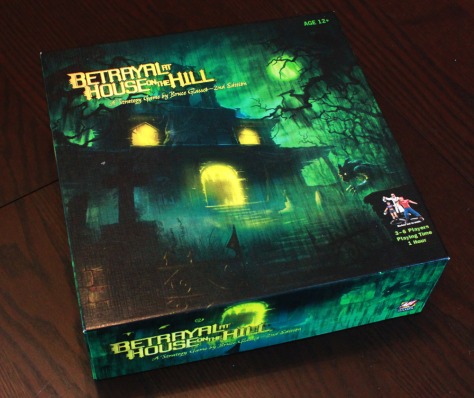 Betrayal at House on the Hill is a very narrative-based board game for 3-6 players of ages 12 and older. The scenario is that the players are a group of explorers, exploring an old haunted house. Whilst exploring the house one player suddenly turns into a traitor, sometimes gaining control of monsters, and the game turns from exploring to a fight for survival between the traitor and the rest of the players. The fight between the players can however be quite different between play sessions, depending on what different rooms and items that have been discovered, as there are a number of different scenarios that affect the goals of all players.
Betrayal at House on the Hill is a very narrative-based board game for 3-6 players of ages 12 and older. The scenario is that the players are a group of explorers, exploring an old haunted house. Whilst exploring the house one player suddenly turns into a traitor, sometimes gaining control of monsters, and the game turns from exploring to a fight for survival between the traitor and the rest of the players. The fight between the players can however be quite different between play sessions, depending on what different rooms and items that have been discovered, as there are a number of different scenarios that affect the goals of all players.
The game board is made up of many individual rooms. Unlike most other board games, Betrayal at House on the Hill doesn’t have a large board with set rooms, but instead the board is made up of individual rooms that are discovered by the players as they move through the mansion. The room-tiles are placed in a shuffled pile, with the back up so that the rooms aren’t visible, from which the players draw rooms when discovering new areas. In the beginning of the game, the board always consist of three specific tiles; the ground floor tile containing the Entrance Hall, the Foyer and the Grand Staircase – which is the only tile containing more than one room – the Upper Landing on the upper floor, and the Basement Landing in the basement.
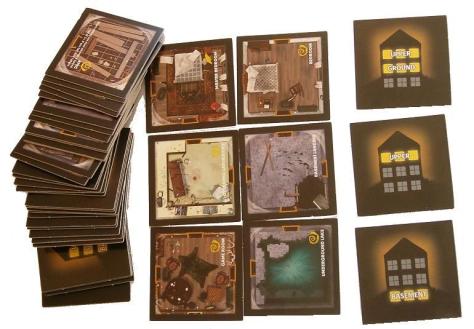 Each room has a name, which is important as some rooms have items (described under Cards) related to them, and as the name of the room that the Haunt is revealed in (described under The Haunt phase) can determine what Haunt scenario is played during this session. Some rooms may be placed on any of the mansions three floors (the Upper floor, the Ground floor or in the Basement), but most of the rooms are restricted to a specific floor. What floor the room is restricted to is indicated on the back of the room-tile. If a new room is discovered, the player discovering the room draws a room from the room-pile, and if the room can’t be placed on the floor the player is on, the tile is put to the side and another is drawn until the player gets a room that fit the floor. When the room-pile is emptied, the rooms put to the side are shuffled into a new pile.
Each room has a name, which is important as some rooms have items (described under Cards) related to them, and as the name of the room that the Haunt is revealed in (described under The Haunt phase) can determine what Haunt scenario is played during this session. Some rooms may be placed on any of the mansions three floors (the Upper floor, the Ground floor or in the Basement), but most of the rooms are restricted to a specific floor. What floor the room is restricted to is indicated on the back of the room-tile. If a new room is discovered, the player discovering the room draws a room from the room-pile, and if the room can’t be placed on the floor the player is on, the tile is put to the side and another is drawn until the player gets a room that fit the floor. When the room-pile is emptied, the rooms put to the side are shuffled into a new pile.
Each room has a set number of doors, and any new rooms added to the board must be placed in such a way so that the rooms are connected by doorways. The placement of the rooms are determined by the player movements, and by walking through a doorway with no room on the other side, a player will discover a new room in that area. This way, the game board may look very different between play sessions, as different rooms are discovered in different areas. If a room-tile is placed in a way so that one or more doors are blocked by another room’s wall, that door is considered blocked, and player will be unable to move through that door.
In addition to the properties mentioned, being the rooms names, the doors, the floor they’re placed on and their relations to each other that is determined by when and where they’re discovered, each room may have a couple of other properties. They may have one of three different symbols on them; the symbol for Event, Item or Omen. Depending on what symbol is depicted on the room-tile, a card from the Event, Item or Omen-pile is drawn. A room might also have unique properties, such as, for example, a staircase that enables transition between floors. Some rooms also require players to make a successful trait-roll (described under Players) or suffer a penalty if not carrying certain items or making a successful trait-roll.
Each player chooses a character in the beginning of the game, complete with a small, painted figurine and a corresponding character card. The character cards are double-sided, allowing for two versions of each character per model, though the player only plays as one character during a session. On the character cards each character has four different traits; Speed and Might that are Physical traits, and Knowledge and Sanity that are Mental traits. Each character begins at a certain number in each of the traits, the number coloured green to indicate it being the starting number, and the amount of points in each trait varies from character to character. Some characters are more physically fit, with less knowledge and sanity, whilst others are very knowledgeable and sane but with little might or speed. The players fasten small clips on the cards to keep track on how high or low their characters different traits are. The traits can be lowered or enhanced during the game depending on what items the player picks up, what rooms they discover, what events they encounter and what omens they find. The traits may also be lowered by the players if they decide to attack one another. At the end of each line of numbers for the different traits there’s a small symbol of a skull, and should a player drop to the skull in any trait the character is considered dead. The characters can’t however die until the Haunt starts, though their stats may be lowered to the lowest number possible if the player is unlucky.
A trait-roll means that the player throws a number of dice corresponding to their current number in said trait, or sometimes the number of dice specified by the event. Depending on the event, the player might want to roll a value higher or lower than the one specified on said event. The dice are six-sided, but doesn’t count from one to six. Instead, the dice has two blank sides for 0, two sides for 1 and two for 2.
The Speed trait is mainly used to determine how quickly the character can move. Going from one room to another requires one point in speed, so for example a character with 3 Speed may move through three rooms during that players turn. The Might trait is mainly used in combat (described under Combat), when attacking either another player or a monster, or defending when being attacked. Some rooms or events do require the player to make a trait-roll with speed or might.
The Knowledge and Sanity traits are primarily used during events that require the player to make a trait-roll in either knowledge or sanity, but may sometimes be used during combat through certain items.
Combat:
Players can engage in combat at any time when two players, or at least one player and a monster are in the same room. Players, however, cannot die and monsters don’t appear until the Haunt starts. Whoever wins in a fight between two players may choose to deal damage or to steal item- or omen-cards from the other player.
When a player attacks either another player or a monster the player throws a number of dice corresponding to their current points in Might. The defending party also throws dice corresponding to their own Might, and the difference between the two throws is the damage. If the attacking party throws a total of 6, and the defending party throws 4, the difference between the two numbers – 2 – is the amount of damage that the defending party takes. It isn’t always the defender that takes damage however. Should the attacker for example throw a 2, and the defender throws a 4, the defenders number is higher, resulting in the attacker taking damage instead, this damage also being the difference between the two numbers. Should the two throw an equal number it’s a draw and neither party takes any damage.
Attacks using Might, which is the primarily used trait in combat, deals physical damage, and if it’s a player taking damage they may choose to distribute the damage taken over their physical traits (Might and Speed) as they wish. Attacks may however in some cases rely on other traits, and if the attack uses Knowledge or Sanity it deals mental damage instead of physical. The mental damage lowers mental traits instead of physical. Mental attacks aren’t possible against all monsters though, as some monsters lack mental traits all together.
Some items and omens may come into play during combat, for example by boosting the attack of one player or enabling the player taking damage to transform mental damage to physical and vice versa.
Depending on what Haunt is revealed during a game session, the player that becomes the Traitor may or may not receive control over one or more monsters. The monsters differ from each other, and their behaviour depends on the monster itself and the Haunt. Some monsters, for example, will attempt to kill the players that aren’t the traitor, whilst some doesn’t necessarily need to kill the players in order to win the game.
The monsters have traits, just like the players, but most monsters don’t have all of the four traits. Some monsters, like Frankenstein’s Monster, only have physical traits, whilst for example Count Dracula and his Bride both have physical traits, as well as the mental trait Sanity. Some monsters also may or may not discover new areas, traverse rooms with penalties without taking damage, ascend and descend through one-way holes in the floor or trap-doors, carry items and more. Generally monsters will also slow players in the same room as the monster, making the player use up two points of speed instead of one in order to leave the room. The specific abilities and traits of one monster is specified in the Haunt in which said monster appears, and the monsters differ a lot from each other.
There are three different kinds of cards in the game, except from the character cards which aren’t really cards, but more of tiles or plates. The three kinds of cards are Items, Omens and Events. If a player has to pick a card upon entering a room, they have to end their turn in that room if the card doesn’t say otherwise.
The Item cards are, as the name indicates, cards depicting different kinds of items that the players may find during the game. Whenever a player enters a room with the item symbol, the player must pick an item from the item card pile. The items on the cards may contain items that add to or draw from the characters different traits, or they may add a number to, or an extra roll to a dice-roll. The player that picked up the item may keep the card through the entire session, or the item might be a one-time-use kind of item that is discarded once used. The player may also choose to drop an item, or trade it with the other players, and should a character die, the player owning said character drops all items in a pile (represented by an Item pile token) in the room where they died. Item piles may be picked up by another player upon entering that room. Some items are entirely represented by a token instead of a card, though this only happens during the Haunt phase if there are any specific items that appear during a specific Haunt.
The Omen cards are usually treated as items, though there are a few exceptions. A player picks an omen from the omen card pile whenever they step into a room with the omen symbol. Even though most omens are treated as items, each omen also force the player that picked it up to make a Haunt roll at the end of their turn (described under The Haunt phase).
The Event cards are picked from the event card pile whenever a player steps into a room with the event symbol on it. The event described on the card is applied as soon as the player collects the card. Most of the events have immediate effects, requiring the player to make trait-rolls to avoid physical or mental damage, or requiring them to discard items. However some events have lingering effects, such as claiming that the character’s flashlight (which isn’t an item, just something that all players are claimed to be carrying at all times) has run out of battery making the player unable to move more than one room during their turn, regardless of how many points they have in speed, until they’ve gotten to a room with another player in it to get a new set of batteries for their flashlight. The lingering event cards are kept by the affected player until it is no longer in affect.
Along with the rule-book for the game, Betrayal at the House on the Hill also contains two scenario booklets, known as the “Traitor’s Tome” and the “Secrets of Survival”. The two booklets aren’t supposed to be read until the Haunt begins, and they both contain information on the different scenarios that the players will need to know when the Haunt starts. Only the Traitor may read the Traitor’s Tome when the Haunt begins, and the other players will read the Secret of Survival. In the Traitor’s Tome, the Traitor will get to know what happens to their character, if they are in control of any monster or monsters, if they turn into a monster, what traits the monsters have and what their goal is that they need to complete in order to win the game. Likewise, the other players – now called Heroes – will get to know what kind of monsters they’re up against, but not the monster’s traits. The Heroes will also get to know what their goal is, if they have to perform any ritual in order to be able to attack the monsters, if they have to slay the monsters or kill the Traitor in order to win the game. The Heroes also gets to know how much damage they must inflict on the monsters in order to kill them, whilst the Traitor doesn’t know how much damage the monsters can take.
The Exploring phase:
During the first half of the game, the players work cooperatively as a group in order to explore more of the mansion. The board starts small, and the play area expands as the players gradually explore more rooms. During the Exploring phase, there isn’t a defined goal to the game other than to widen the play area with more rooms and strengthening your character through the collection of items and omens, or the experience of events. During the Exploration phase, the players cannot die.
The Haunt phase:
Whenever a player picks an Omen card, the player has to make a Haunt roll at the end of their turn. The number of dice thrown is equal to the number of players in the game, and if the player making the Haunt roll throws a number that is less than the amount of Omen cards in play, the Haunt phase will begin. The player that threw the dice then becomes the Haunt revealer, and the Haunt revealer then opens the Traitor’s Tome on the first page to see what Haunt has been revealed. Depending on what room the Haunt revealer is standing in, and what Omen it was that was just picked, a Haunt is decided, and a Traitor is revealed. It isn’t necessarily the Haunt revealer that is the traitor. Unlike the Exploration phase, when the Haunt has been revealed all players can die.
The setting for each Haunt varies depending on which of the fifty scenarios that is played. Most of the scenarios split the players into two groups, one with the Traitor and one with the Heroes, though there are a small number of Haunts that either has a Hidden Traitor, or no Traitor at all. As described earlier, the Traitor then reads the Traitor’s Tome whilst the Heroes read the Secrets of Survival in order to know what scenario is played and what their different goals are. The Traitor never knows what goal the Heroes have to fulfil in order to win, and vice versa. The goal may or may not be to kill the other players, to defeat a monster, to collect certain items and perform rituals or to occupy as many rooms as possible with monster-tokens (small tokens representing monsters, used by the Traitor in certain scenarios), and the goals vary widely from Haunt to Haunt. When either the Traitor or the Heroes have fulfilled their goal, the game ends.
Core Game System:
I had a hard time to decide upon what I believe to be the core of the game, as there are many different parts that make this game a whole, and as the game changes from session to session. I find the Movement of the characters to be the core system of the game, as the player’s movements is used to explore the mansion, building the play field, finding items, omens and triggering events. The exploration is a very big part of the game, and even after the Haunt begins the players are able to keep exploring in order to find new ways to tackle the goals set for them.
However, I also think that the different traits are a big part of the game, as the traits determine how many rooms a character may pass through, how many dice that is thrown during combat, and affect how well the character copes with events and the Haunt. Using the different traits as a life-indicator as well, where a character is considered dead as soon as one of the traits drops to the skull symbol, also encourages the players to explore and collect items and omens in order to strengthen themselves.
The most Interesting System:
The most interesting system in this game is the Haunt, as it might change the game entirely depending on which of the fifty different scenarios is played. This adds a lot of re-playability to the game, and prevents the game from becoming all too predictable. The fact that there isn’t a pre-determined “bad guy” in the game, as the Traitor isn’t decided until the Haunt is revealed, also helps to keep the players on their toes. They cannot know beforehand which one of them will become the Traitor, and that makes it harder to gang up on one player and try to lower all of their stats in order for them to be more vulnerable, as that player might not be the Traitor.
The fact that the Haunt varies widely from session to session depending on what the players happen to find whilst exploring means that it’s hard for players to prepare, as they don’t know what’s coming, and that adds a lot of positive tension to the game.
The Best parts of the game:
There are many good things with this game, and choosing one is hard. The fact that the dices only count to 2, and has two blank sides gives the player the chance to evade penalty if they manage to score certain numbers, as well as it makes the player throw similar throws instead of one player throwing very high numbers whilst another only gets low numbers. This is a good part, as the players have to throw dices many times during the game, and the game would either have become a lot harder with higher numbers, or ended a lot quicker if the players could easily kill the monsters or other players with one roll of the dice.
Another good part of the game, and probably the best part, is the board itself, with all of its individual rooms. The games core being exploring, one of the best parts of the game is the fact that the players are actually exploring the mansion. The players discover the rooms in different locations and at different times from session to session, thus creating a new play field and story each time as the players find other items and reveal other Haunts, leading to much re-playability.
The Not-so-good-part of the game:
The different player-characters felt a bit unbalanced, as some characters tended to become overpowered quickly. The changes in trait-points where often sudden, which in some cases could be positive as it contributed to the tension of the game, but sometimes a little luck could leave a character severely overpowered, or underpowered. The game sometimes felt as if it snowballed a little too easy, as a player with high points in traits easily gained even more points, whilst a player with fewer points more easily lost more points.
Who would like to play this game?
The box of the game says that the game targets an audience from 12 years old and higher. Though I do believe that a younger player might be able to play the game, as most of the rules are quite straight forward, I do believe that 12 is a good age to set as the lowest. Even though the rules are quite straight forward, it might be hard for a child below the age of 12 to keep track of everything alone when turned into a Traitor. It might also feel difficult for a younger, less mature child to be turned against by all other players when they’re the traitor. This might be solved by letting the Traitor gain help from an older player or parent. The games narrative also suggests that the game isn’t for younger children, as, for example, one of the Haunts describes how the Traitor trashes about before bending, being split in two and turns into the two-headed serpent Ouroboros.
Summary:
Betrayal at House on the Hill is a narrative-based board game with a lot of exploration and a sense of horror through uncertainty and sudden betrayal as well as the horror themed haunted mansion and monsters. The game has a high re-playability, and the many different scenarios allows for a different experience during each new session. Even though the game tends to snowball a little with the traits, it doesn’t destroy the experience, and I’ve enjoyed this game a lot.
That’s all for now. I’m sorry for the late and very long post, and I hope that you all have a great week!
None of the images used are mine.
MPh out.
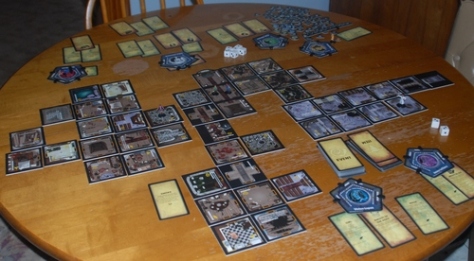
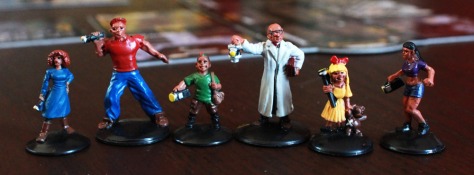
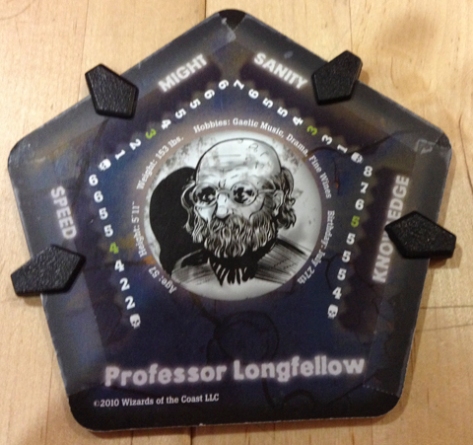
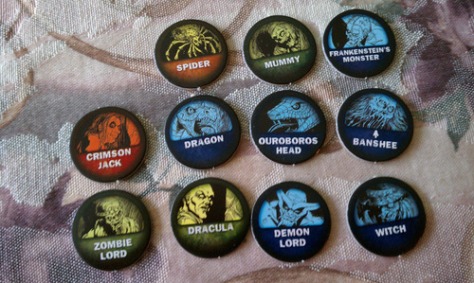
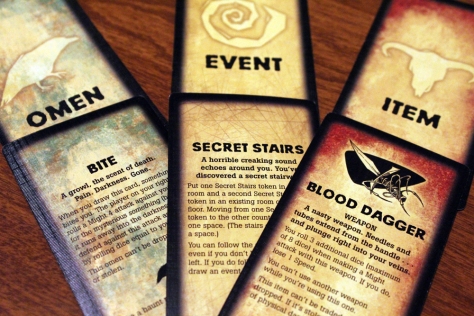
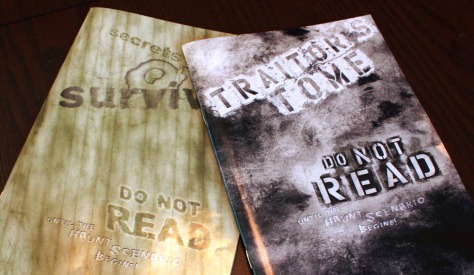
[…] (The analysis can be found here: https://moonphanter.wordpress.com/2014/09/29/board-game-analysis-betrayal-at-house-on-the-hill/) […]
This is my review of Jonna’s (from Group 9) analysis of the board game Betrayal at House on the Hill.
This is the comment version of the review, the blog post version (better formatting) can be found here: http://islandgamelog.wordpress.com/2014/10/02/board-game-review-2-betrayal-at-house-on-the-hill/
– – –
The Core Game System: I agree that the core system is the player/character movement. It’s what moves the game’s story forward, and if the players didn’t move around there wouldn’t be any new rooms to the mansion, and nothing would really happen since most events are triggered by entering a room. (It would be a very uneventful game. In fact, I don’t think it even would be a game.)
I also agree that the character traits are an important system as well. They affect the players’ ability to move, and having good stats in the different traits equals having good physical and mental strength.
There are several events in the game, both card and room based events, where the player may sustain either physical or mental damage depending on the stats of their traits. If the player has low stats in any of these traits, there will be a bigger risk that they will get hurt in that specific area (since they get to throw fewer dice), so it is really important for all the players to try to have as good stats as possible.
I think the trait system was a good way to illustrate the fact that it’s easier to withstand physical or mental treats or attacks if you have a strong body or mind, and it gave the game a nice dimension. The risk of having a player character losing their mind (being defeated) due to events that may lower their mental traits, or just not being physically strong enough, added to the tension of the game and the story.
The Most Interesting System: I liked the Haunt system too, and thought it was really interesting that there were so many different scenarios that could happen in the game.
The fact that the Haunt is picked depending on what room the Haunt revealer was in, and the omen card that was drawn, was really fascinating and a very good way to do it. Having two different factors affecting the Haunt makes it a lot more difficult to foresee what Haunt it is that will be picked, and it’s a lot more difficult to remember what combinations triggers what scenario/Haunt than if the only factor had been the room or the omen card. It’s something that supports the re-playability of the game, and makes it unpredictable even for players that have played the game several times before.
This unpredictability of the game is very important for other reasons as well. Just like Jonna said, there would be a risk of players ganging up on one player if they were able to foresee which player it was that would turn into the traitor, and it would have made the game significantly less dramatic.
As it is now, the uncertain situation creates suspense and tension, and when the traitor is revealed, the feeling of “betrayal” will be stronger than if everyone had suspected one player all along.
It feels like the creators of the game have balanced it really well, and it’s the system that creates the most drama in the game and affects the game situation the most. Along with the Player Movement and the Character Trait systems it creates a really intriguing game, and due to its unpredictability, I believe that it’s very unlikely for players to get exactly the same scenario when playing the game again.
Best part of the game: I agree that exploring the mansion and its rooms was the best part of the game. I really liked how the narrative was built up through the game, with every room being like a piece of puzzle for the players to place out, and that the events that could happen were either connected to the room or to a card that were drawn in the room.
The element of randomization when it came to the room cards and the other cards gave the game a feeling of mystery and danger, and just like in a horror story you never knew what would happen next. Sometimes you went into a room that seemed harmless, but then got a card that triggered a bad event or vice versa. Other times you went into a room and found an item, and thinking about what kind of room it was, the state it was in, and the item that you got, you could get an idea of a potential backstory for that room.
But there were times where the room and the item (or event) didn’t match that well when my group played. One example was when a player entered the “graveyard room” and found a closet and a safe there (where the latter was hidden behind a painting on the wall). The graveyard was obviously outdoors by looking at its card, which showed a graveyard with a fence around it, so it felt rather confusing and strange to find both a closet and a safe there. But since this is a horror game, and there had been happening other weird things to the players before that, I guess details like that can be overlooked.
When it comes to the dice in the game, I’m not that sure if I can agree completely with Jonna. I really liked the dice value of 0-2 and for the same reasons, but I didn’t like that you had to throw so many of them sometimes. In some cases a player needed to throw 6 dices, and when my group played we didn’t really have that much space on the table because of the expanding game board, which made it very difficult to find anywhere to throw them without ruining something. It always became a bit of a stressful situation when we had to throw more than 4 dice, and it felt like it could have been done a bit different. I would have preferred if there were fewer dice.
Worst part of the game: I didn’t notice the tendency of the character traits becoming either overpowered/underpowered, but it would maybe have been more evident if my group had played the game some more times. I can imagine it being that way though, because we only had one player that increased his character traits a lot while the others pretty much had the same stats throughout the game when we played, but I don’t really know. I didn’t lose or gain that many trait points when we played, so if it was something I thought was strange, it was that I rarely had any chance/risk of gaining or losing any.
I think that the worst part of the game was that there were scenarios/Haunts where only one player could really fight and defeat the enemies. When my group played the game, we got a Haunt where the traitor controlled poison ivy vines (with roots that stayed in their respective rooms) and the only way to defeat them was to get a special item that only one player (who had the required item) could get. With this item, the player only needed to be in the same room as a vine or a root in order to destroy it.
All of the players that couldn’t get the item didn’t really have much to do, because they could only stun the enemies by winning against them in a “might roll” during an attack. You could say that their role was to merely stay alive and defend themselves until the player with the item had destroyed all the enemies, but since we had explored most of the ground floor where most of the enemies were, there were a lot of places for the players to get away and hide from the vines which made it all rather uneventful.
I would have preferred if the players could have defeated the vines, or that they would have come back into the game after two turns instead of just having them stunned for one turn, because I think that every player should’ve been able to defeat the enemies. That way, the players could at least have chosen to try and help fighting against the monsters, instead of not being able to do any permanent damage at all.
I do understand the narrative point of view though since the fact that there’s only one weapon to defeat the monsters makes the situation difficult, and if the player were to lose that item (which is possible), the hero players would find themselves in a lot of trouble and risk defeat. So as it is now, there’s potential dramatic tension and feeling of danger in the situation, but there’s also a risk that there will be a group of players with not much to do. (It’s possible that this was the only Haunt in the whole game that had a setting like this though…)
Target Group: I agree when it comes to the age recommendation of “12 years and up”. It is probably possible for someone younger to play this game, but the horror theme may frighten or upset them, and keeping track of all the details can turn out difficult.
Jonna mentioned that there might be some problems if a younger player becomes the traitor, that they maybe will feel uncomfortable about the other players turning against them, but it’s was a good solution to suggest that they would be able to ask an older player for help.
I think that another solution to that problem would be to just pass the traitor role to another player, so that the players that would be distressed playing the traitor can play one of the hero roles instead. (However this requires that there is more than one player that wouldn’t mind being the traitor. Otherwise the suspense of the whole traitor part of the game would be lost.)
In general I think that this game works really well for “teens and up”, but a younger player could play this game if they don’t mind the horror theme and the risk of being the traitor.
Summary:
I agreed with Jonna on the systems, the core system being the Player Movement (and Character Traits) and the Haunt system being the most interesting. I also agreed when it came to the target group and age recommendation, with “12 years and up” being a good recommendation but that a younger player might be able to play the game. (Depending on if they don’t mind the horror theme and won’t feel uncomfortable playing the traitor role.)
The only thing I slightly disagreed with was when it came to the best parts of the game, where I didn’t really like the game’s dices as much (mostly because there were too many to throw sometimes) but I agreed on some things. When it comes to the worst parts of the game, I hadn’t noticed the tendency of overpowered/underpowered character traits that Jonna mentioned, so I couldn’t really comment on anything about that.
I did agree on that the best part of the game was to explore the mansion though, and I would maybe have noticed the character trait problem if I had played the game more times. For now, I thought that the worst part of the game were the fact that the Haunt that my group got during our session only had one player that could really fight against the enemies, while the others only could stun and run away from them. I would have preferred that every player could at least have been able to do some damage, but maybe not as permanent as the player with the special item.
In general I thought that it was a good and well-written analysis, and it covered the different aspects of the game very well.
[…] This is the blog post version of the review, the comment version can be found here: https://moonphanter.wordpress.com/2014/09/29/board-game-analysis-betrayal-at-house-on-the-hill/commen… […]